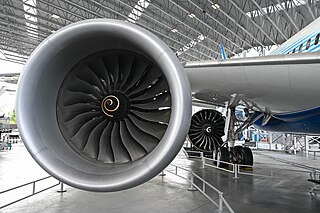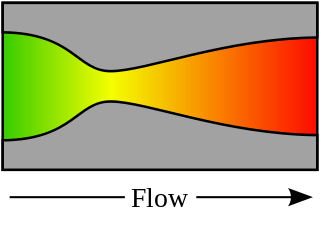Units
| Specific impulse | Effective exhaust velocity | Specific fuel consumption | ||
|---|---|---|---|---|
| By weight | By mass | |||
| SI | = x s | = 9.80665·x N·s/kg | = 9.80665·x m/s | = 101,972/x g/(kN·s) |
| English engineering units | = x s | = x lbf·s/lb | = 32.17405·x ft/s | = 3,600/x lb/(lbf·hr) |
The most common unit for specific impulse is the second, as values are identical regardless of whether the calculations are done in SI, imperial, or customary units. Nearly all manufacturers quote their engine performance in seconds, and the unit is also useful for specifying aircraft engine performance. [5]
The use of metres per second to specify effective exhaust velocity is also reasonably common. The unit is intuitive when describing rocket engines, although the effective exhaust speed of the engines may be significantly different from the actual exhaust speed, especially in gas-generator cycle engines. For airbreathing jet engines, the effective exhaust velocity is not physically meaningful, although it can be used for comparison purposes. [6]
Metres per second are numerically equivalent to newton-seconds per kg (N·s/kg), and SI measurements of specific impulse can be written in terms of either units interchangeably. This unit highlights the definition of specific impulse as impulse per unit mass of propellant.
Specific fuel consumption is inversely proportional to specific impulse and has units of g/(kN·s) or lb/(lbf·hr). Specific fuel consumption is used extensively for describing the performance of air-breathing jet engines. [7]
Specific impulse in seconds
This section needs additional citations for verification .(August 2019) |
Specific impulse, measured in seconds, effectively means how many seconds a given propellant, when paired with a given engine, can accelerate its own initial mass at 1 g. The longer it can accelerate its own mass, the more delta-V it delivers to the whole system.
In other words, given a particular engine and a mass of a particular propellant, specific impulse measures for how long a time that engine can exert a continuous force (thrust) until fully burning that mass of propellant. A given mass of a more energy-dense propellant can burn for a longer duration than some less energy-dense propellant made to exert the same force while burning in an engine. Different engine designs burning the same propellant may not be equally efficient at directing their propellant's energy into effective thrust.
For all vehicles, specific impulse (impulse per unit weight-on-Earth of propellant) in seconds can be defined by the following equation: [8]
where:
- is the thrust obtained from the engine (newtons or pounds force),
- is the standard gravity, which is nominally the gravity at Earth's surface (m/s2 or ft/s2),
- is the specific impulse measured (seconds),
- is the mass flow rate of the expended propellant (kg/s or slugs/s)
The English unit pound mass is more commonly used than the slug, and when using pounds per second for mass flow rate, the conversion constant g0 becomes unnecessary, because the slug is dimensionally equivalent to pounds divided by g0:
Isp in seconds is the amount of time a rocket engine can generate thrust, given a quantity of propellant whose weight is equal to the engine's thrust. The last term on the right, , is necessary for dimensional consistency ()
The advantage of this formulation is that it may be used for rockets, where all the reaction mass is carried on board, as well as airplanes, where most of the reaction mass is taken from the atmosphere. In addition, it gives a result that is independent of units used (provided the unit of time used is the second).

Rocketry
In rocketry, the only reaction mass is the propellant, so the specific impulse is calculated using an alternative method, giving results with units of seconds. Specific impulse is defined as the thrust integrated over time per unit weight-on-Earth of the propellant: [9]
where
- is the specific impulse measured in seconds,
- is the average exhaust speed along the axis of the engine (in m/s or ft/s),
- is the standard gravity (in m/s2 or ft/s2).
In rockets, due to atmospheric effects, the specific impulse varies with altitude, reaching a maximum in a vacuum. This is because the exhaust velocity isn't simply a function of the chamber pressure, but is a function of the difference between the interior and exterior of the combustion chamber. Values are usually given for operation at sea level ("sl") or in a vacuum ("vac").
Specific impulse as effective exhaust velocity
This section needs additional citations for verification .(August 2019) |
Because of the geocentric factor of g0 in the equation for specific impulse, many prefer an alternative definition. The specific impulse of a rocket can be defined in terms of thrust per unit mass flow of propellant. This is an equally valid (and in some ways somewhat simpler) way of defining the effectiveness of a rocket propellant. For a rocket, the specific impulse defined in this way is simply the effective exhaust velocity relative to the rocket, ve. "In actual rocket nozzles, the exhaust velocity is not really uniform over the entire exit cross section and such velocity profiles are difficult to measure accurately. A uniform axial velocity, ve, is assumed for all calculations which employ one-dimensional problem descriptions. This effective exhaust velocity represents an average or mass equivalent velocity at which propellant is being ejected from the rocket vehicle." [10] The two definitions of specific impulse are proportional to one another, and related to each other by:
where
- is the specific impulse in seconds,
- is the specific impulse measured in m/s, which is the same as the effective exhaust velocity measured in m/s (or ft/s if g is in ft/s2),
- is the standard gravity, 9.80665 m/s2 (in United States customary units 32.174 ft/s2).
This equation is also valid for air-breathing jet engines, but is rarely used in practice.
(Note that different symbols are sometimes used; for example, c is also sometimes seen for exhaust velocity. While the symbol might logically be used for specific impulse in units of (N·s3)/(m·kg); to avoid confusion, it is desirable to reserve this for specific impulse measured in seconds.)
It is related to the thrust, or forward force on the rocket by the equation: [11]
where is the propellant mass flow rate, which is the rate of decrease of the vehicle's mass.
A rocket must carry all its propellant with it, so the mass of the unburned propellant must be accelerated along with the rocket itself. Minimizing the mass of propellant required to achieve a given change in velocity is crucial to building effective rockets. The Tsiolkovsky rocket equation shows that for a rocket with a given empty mass and a given amount of propellant, the total change in velocity it can accomplish is proportional to the effective exhaust velocity.
A spacecraft without propulsion follows an orbit determined by its trajectory and any gravitational field. Deviations from the corresponding velocity pattern (these are called Δv) are achieved by sending exhaust mass in the direction opposite to that of the desired velocity change.
Actual exhaust speed versus effective exhaust speed
When an engine is run within the atmosphere, the exhaust velocity is reduced by atmospheric pressure, in turn reducing specific impulse. This is a reduction in the effective exhaust velocity, versus the actual exhaust velocity achieved in vacuum conditions. In the case of gas-generator cycle rocket engines, more than one exhaust gas stream is present as turbopump exhaust gas exits through a separate nozzle. Calculating the effective exhaust velocity requires averaging the two mass flows as well as accounting for any atmospheric pressure.[ citation needed ]
For air-breathing jet engines, particularly turbofans, the actual exhaust velocity and the effective exhaust velocity are different by orders of magnitude. This happens for several reasons. First, a good deal of additional momentum is obtained by using air as reaction mass, such that combustion products in the exhaust have more mass than the burned fuel. Next, inert gases in the atmosphere absorb heat from combustion, and through the resulting expansion provide additional thrust. Lastly, for turbofans and other designs there is even more thrust created by pushing against intake air which never sees combustion directly. These all combine to allow a better match between the airspeed and the exhaust speed, which saves energy/propellant and enormously increases the effective exhaust velocity while reducing the actual exhaust velocity.[ citation needed ] Again, this is because the mass of the air is not counted in the specific impulse calculation, thus attributing all of the thrust momentum to the mass of the fuel component of the exhaust, and omitting the reaction mass, inert gas, and effect of driven fans on overall engine efficiency from consideration.
Essentially, the momentum of engine exhaust includes a lot more than just fuel, but specific impulse calculation ignores everything but the fuel. Even though the effective exhaust velocity for an air-breathing engine seems nonsensical in the context of actual exhaust velocity, this is still useful for comparing absolute fuel efficiency of different engines.
Density specific impulse
A related measure, the density specific impulse, sometimes also referred to as Density Impulse and usually abbreviated as Isd is the product of the average specific gravity of a given propellant mixture and the specific impulse. [12] While less important than the specific impulse, it is an important measure in launch vehicle design, as a low specific impulse implies that bigger tanks will be required to store the propellant, which in turn will have a detrimental effect on the launch vehicle's mass ratio. [13]
Specific fuel consumption
Specific impulse is inversely proportional to specific fuel consumption (SFC) by the relationship Isp = 1/(go·SFC) for SFC in kg/(N·s) and Isp = 3600/SFC for SFC in lb/(lbf·hr).






















